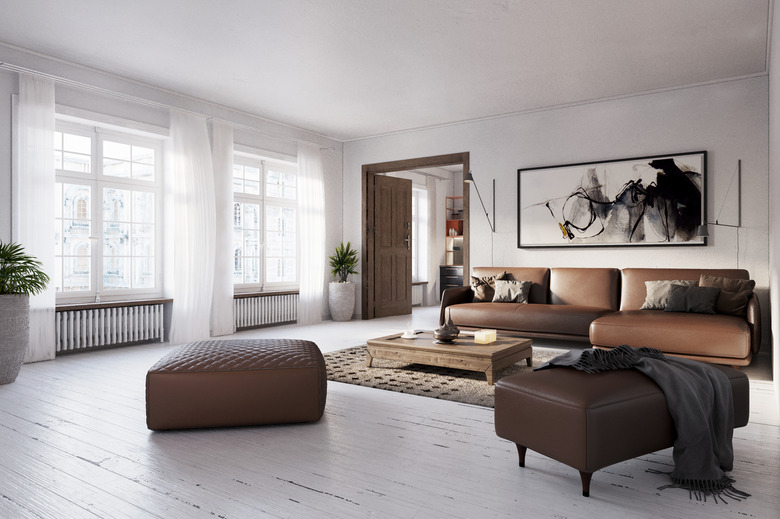Can You Paint Over Water-Based Polyurethane?
We may receive a commission on purchases made from links.
One day, you may look around and realize that your décor is outdated and perhaps a bit grungy. Whether you're tired of old dark wood or refurbishing and/or repurposing an older piece, you can paint over water-based polyurethane with proper prior preparation. It's not uncommon to have a sturdy polyurethane finish applied over a painted surface, especially in high-use areas, like kitchens and bathrooms. While it takes a little extra effort, that outdated or ugly blonde, knotty pine, bland brown, pickled, or other finish can soon become a fresh surface in your favorite color. Here's what's important to know about painting over water-based polyurethane.
Tip
You can paint over water-based polyurethane if you prepare the original finish by cleaning and sanding the surface to ensure a good "grip" for the new paint.
Take Precautions First
Take Precautions First
Before you begin, gather your safety gear: gloves, safety goggles, and a mask or respirator. If any painted furniture, walls, or cabinets were built or installed before 1978, have them tested for lead paint with a lead test kit or call in a professional before sanding. You may have received a brochure from your realtor or landlord about lead paint before moving into your home.
Remove hardware and cabinet doors and take everything possible outside into a carport, covered patio, or garage. Alternatively, open doors and windows and turn on exhaust fans while prepping and painting. Put down plastic sheeting or a painter's drop cloth to protect the floor and/or counters. Also use painter's tape to mask off areas that you don't want to paint.
Prep Before Painting
Prep Before Painting
Before you paint, take time to prep the polyurethane surface. Put on your safety gear and:
- Mix dishwashing liquid and warm water to make a cleaning solution.
- Scrub the surface with a rag or nylon scrubber.
- Wipe it with a wet rag.
- Allow it to dry completely.
For extremely dirty or greasy surfaces, mix TSP (trisodium phosphate) and water according to the package directions and use a nylon scrubber or scrub brush. Rinse by wiping the surface with fresh water and rags or a sponge.
After cleaning, scuff the surface with 220-grit sandpaper or a synthetic steel-wool pad. Avoid using steel wool when working with water-based products, as tiny particles left behind can rust and mar the final finish. Whatever you use, it needs to take the shine off the polyurethane. Then wipe with a damp rag or a tack cloth to remove dust and debris.
Finally, fill any cracks, crevices, or damaged areas with wood filler. Allow it to dry completely and then give the surface another quick sanding with a 220- and then a 60- or 80-grit sandpaper or fine scuff pad. Wipe again to remove dust before painting.
Paint Over Water-Based Polyurethane
Paint Over Water-Based Polyurethane
After prepping the surface, apply two coats of an acrylic latex primer. While oil-based primers and paints may be available, they release fumes from volatile organic compounds (VOCs) and require solvents for cleanup. Water-based, low- or no-VOC products are easier to work with when refurbishing furniture and cabinets. If covering dark paint or wood, consider tinting the primer first to ensure complete coverage. When applying the primer:
- Paint around the edges of the piece with a synthetic-bristle paintbrush.
- Fill in the flat areas with a smooth roller.
- Touch up as needed to ensure the brushed and rolled surfaces match.
- Allow it to dry.
- Sand lightly if necessary.
- Apply a second coat of primer.
- Allow it to dry for the recommended time before applying the paint.
Repeat the process with your selected paint color. You may still need two coats of paint to completely cover the surface. Allow the paint to completely cure. Then, if desired, scuff the surface lightly with a fine-grit sandpaper or scuff pad, wipe it clean, and apply two coats of a water-based polyurethane.
